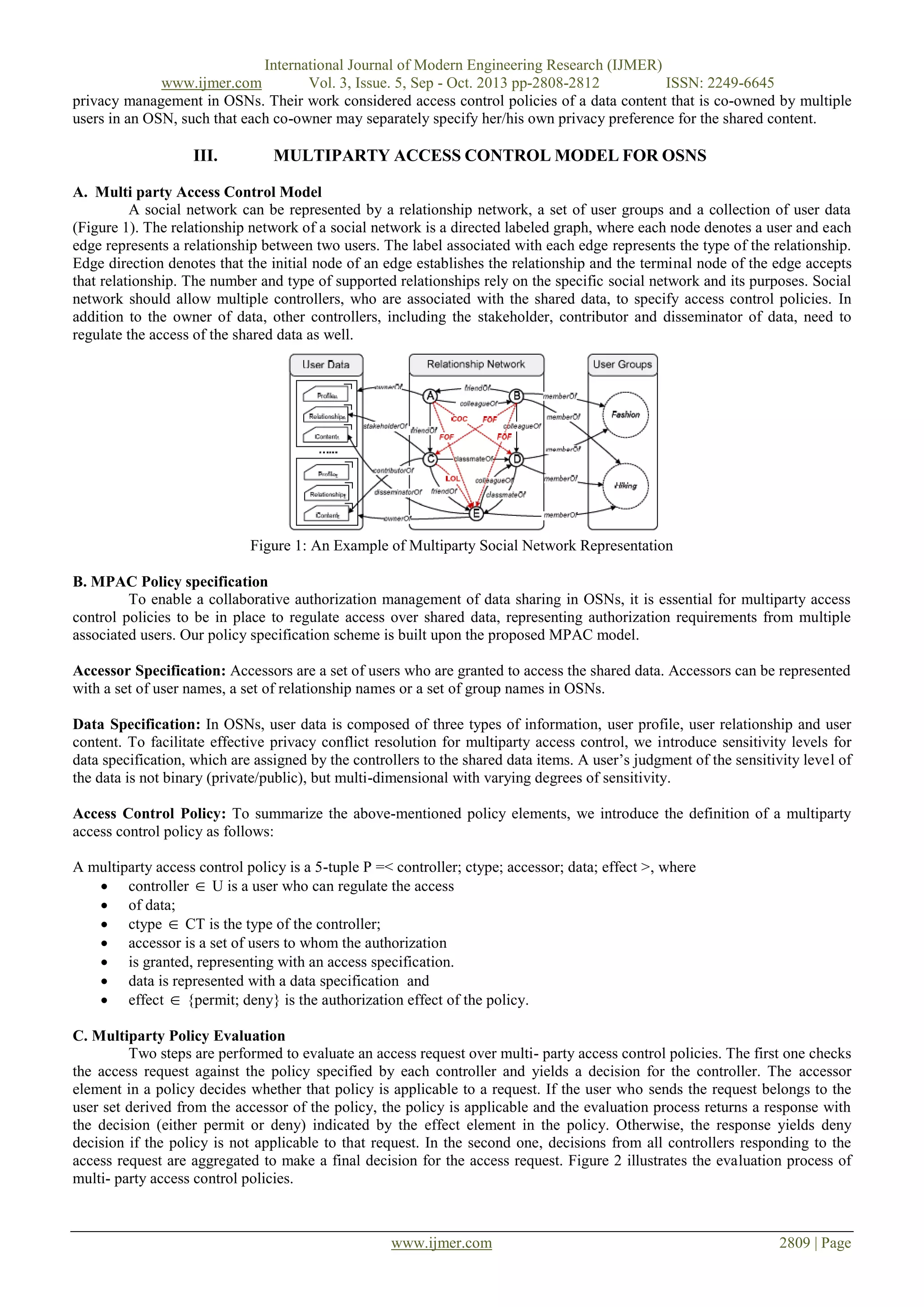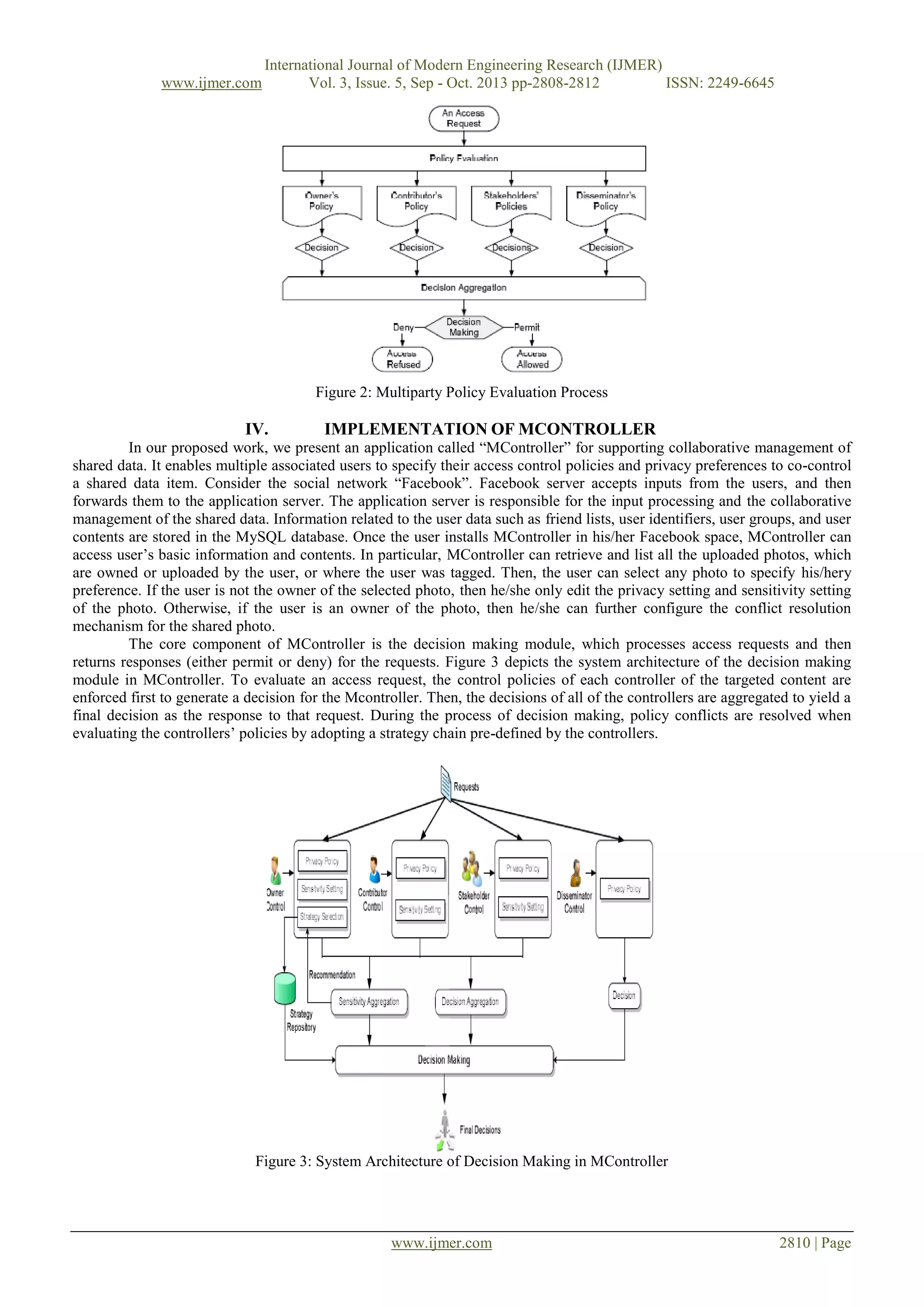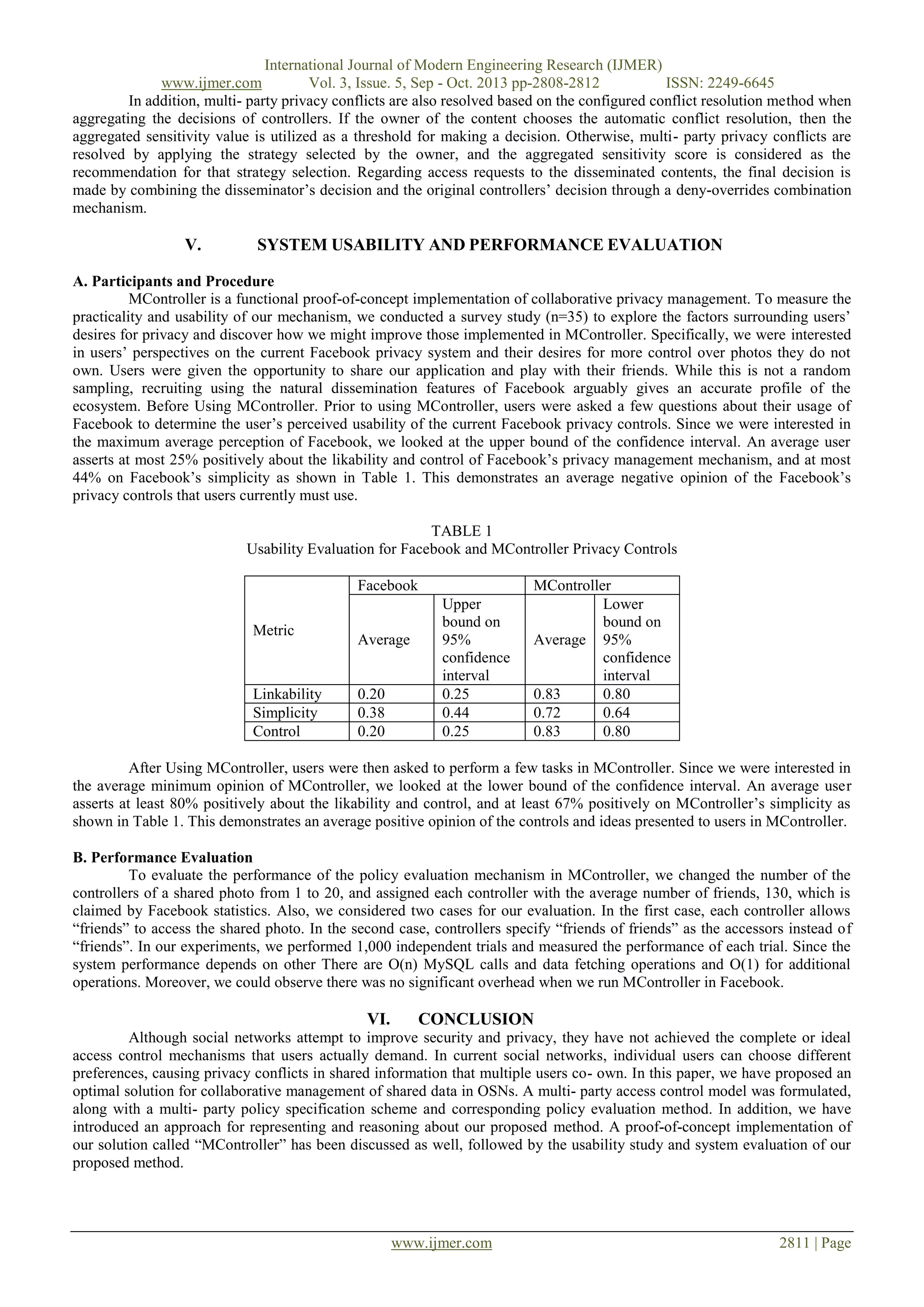This document presents a multi-party access control model for managing shared data in online social networks. It proposes that access control policies for shared data should be specified collaboratively by multiple associated users, not just the data owner. An access control policy format is defined that includes the controller, controller type, accessor, data specification, and authorization effect. A prototype application called MController is implemented that allows multiple users to specify access control policies and resolve conflicts for shared photos. An evaluation of MController found that users had a more positive view of its privacy controls compared to Facebook's default controls. Performance testing showed the policy evaluation mechanism scaled well as the number of controllers increased.
![www.ijmer.com
International Journal of Modern Engineering Research (IJMER)
Vol. 3, Issue. 5, Sep - Oct. 2013 pp-2808-2812
ISSN: 2249-6645
An Access Control Model for Collaborative Management of
Shared Data in OSNS
Ch. Aruna1, G. Minni2
1
M.Tech, Nimra College of Engineering & Technology, Vijayawada, A.P., India.
Asst. Professor, Dept.of CSE, Nimra College of Engineering & Technology, Vijayawada, A.P., India.
2
ABSTRACT: Online social networks (OSNs) have attracted a large amount of users to regularly connect, interact and
share information with each other for various purposes. Users share a tremendous amount of content with other users in
social networks using various services. The recent growth of social network sites such as Twitter, Facebook and MySpace
has created many interesting and challenging security and privacy problems. In OSNs, users manage their profile, interact
with other users, and selforganize into different communities. Users profiles usually include information such as the user’s
name, address, birthdate, contact information, emails, education, interests, photos, music, videos, blogs and many other
attributes The explosive growth of private or sensitive user data that are readily available in OSNs has raised an urgent
expectation for effective access control that can protect these data from unauthorized users in OSNs. This paper presents an
access control model for the protection of shared data associated with multiple users in online social networks.
Keywords: Access control, MController, OSN, Privacy.
I.
INTRODUCTION
Online social networks (OSNs) serve a number of purposes, but three primary roles stand out as common across all
sites. First, OSNs are used to maintain and strengthen existing social ties, or make new social connections. The sites allow
users to “articulate and make visible their online social networks”, thereby “communicating with people who are already a
part of their extended social network” [1]. Second, OSNs are used by each member to upload her own content. Note that the
content shared often varies from site to site, and sometimes is only the user’s profile itself. Third, OSNs are used to find new,
interesting content by filtering, recommending, and organizing the content uploaded by users.
Full participation in OSNs requires users to register a (pseudo) identity with the network, though some sites do
allow browsing public data without explicit sign-on. Users may volunteer information about themselves, for example their
birthday, place of residence, interests, etc., all of which constitutes the user’s profile. The online social network itself is
composed of links between users. Some sites allow users to link to any other user, without consent from the link recipient,
while other sites follow a two-phase procedure that only allows a link to be established when both parties agree. Certain
sites, such as Flickr, have social networks with directed links- meaning a link from A to B does not imply the presence of a
reverse link, whereas others, such as Orkut, have social networks with undirected links. Most sites also enable users to create
special interest groups, which are akin to Usenet [2] newsgroups. Users can post messages to groups (visible to all group
members) and even upload shared content to that group. Certain groups are moderated, and admission to the group is
controlled by a single group administrator, while other groups are open for any member to join. All sites today require
explicit group declaration by the users; users must manually create groups, appoint administrators (if necessary), and declare
which groups they are a member of.
Once an identity is built, users of content sharing sites can upload content onto their account. Many such online
sites enable users to mark content as public (visible to anyone) or private (visible only to their immediate “friends”), and to
tag content with labels. Many sites, such as YouTube, allow users to upload an unlimited amount of video content, while
other sites, such as Flickr, require that users either pay a subscription fee or be subject to an upload limit. All of the content
uploaded by a given user is listed in their user’s profile, allowing other users to browse through the social network to
discover new content. Typically, the content is automatically indexed, and, if publicly available, made accessible though a
textual search. An example is Flickr’s photo search, which allows the users to locate photos by searching based on tags and
comments.
II.
RELATED WORK
Several studies have examined the interface design to support user awareness of the privacy risks and algorithms for
relationship-based access-control scheme. In [3], the authors presented a social-networking-based access-control scheme for
online information sharing by considering identities as key pairs and identifying the social relationship based on social
attestations. Under this approach, a simple access-control list is employed to manage user access. A more sophisticated
mechanism to manage access controls in [4], is rule- based and follows complex policies that are expressed as constraints on
the type, depth, and trust level of existing relationships. This control methods is further extended by making access-control
decisions completely decentralized and collaborative [5].
In [6], the authors introduced a conceptually-similar but more comprehensive trust-based access control model. This
model allows the specification of access rules for online resources, where legitimate users are denoted in terms of the
relationship type, depth, and trust level between users in OSNs. In [7], the authors proposed an access control model that
formalizes and generalizes the access control mechanism implemented in Facebook, admitting arbitrary policy vocabularies
that are based on theoretical graph properties. In [8], the authors described relationship-based access control as one of new
security paradigms that addresses unique requirements of Web 2.0. In [9], the authors provided a solution for collective
www.ijmer.com
2808 | Page](https://image.slidesharecdn.com/bd3528082812-131112033931-phpapp01/75/An-Access-Control-Model-for-Collaborative-Management-of-Shared-Data-in-OSNS-1-2048.jpg)



![www.ijmer.com
International Journal of Modern Engineering Research (IJMER)
Vol. 3, Issue. 5, Sep - Oct. 2013 pp-2808-2812
ISSN: 2249-6645
REFERENCES
[1]
[2]
[3]
[4]
[5]
[6]
[7]
[8]
[9]
Danah boyd and Nicole B. Ellison. Social network sites: Definition, history, and scholarship. Journal of Computer-Mediated
Communication, 13(1), 2007.
Bryan Pfaffenberger. The USENET Book: Finding, Using, and Surviving News- groups on the Internet. Addison Wesley, New
York, NY, USA, 2004.
Kiran K. Gollu, Stefan Saroiu, & Alec Wolman. (2007, October). A Social Networking-Based Access Control Scheme for Personal
Content Proc. 21st ACM Symposium on Operating Systems Principles (SOSP ’07), Stevenson,Washington. (WIP)
Carminati, B., Ferrari, E., & Perego, A. (2006, October). Rule-based access control for social networks. Paper presented at the On
the Move to Meaningful Internet SystemsWorkshops.
Carminati, B., & Ferrari, E. (2008, October). Privacy-aware collaborative access control in Web-based social networks. Paper
presented at the 22nd annual IFIPWorking Group 11.3Working Conference on Data and Applications Security, London, UK.
B. Carminati, E. Ferrari, and A. Perego. Rule-based access control for social networks. In On the Move to Meaningful Internet
Systems 2006: OTM 2006 Workshops, pages 1734–1744. Springer, 2006.
P. Fong, M. Anwar, and Z. Zhao. A privacy preservation model for facebook-style social network systems. In Proceedings of the
14th European conference on Research in computer security, pages 303–320. Springer-Verlag, 2009.
E. Carrie. Access Control Requirements for Web 2.0 Security and Privacy. In Proc. of Workshop on Web 2.0 Security & Privacy
(W2SP). Citeseer, 2007.
A. Squicciarini, M. Shehab, and F. Paci. Collective privacy management in social networks. In Proceedings of the 18th
international conference on World wide web, pages 521–530. ACM, 2009.
www.ijmer.com
2812 | Page](https://image.slidesharecdn.com/bd3528082812-131112033931-phpapp01/75/An-Access-Control-Model-for-Collaborative-Management-of-Shared-Data-in-OSNS-5-2048.jpg)